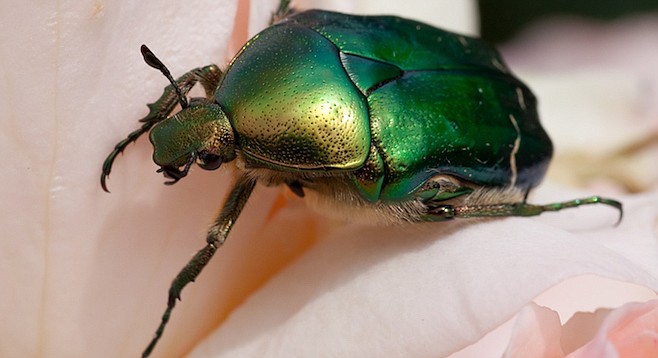 Facebook
Facebook
 X
X
 Instagram
Instagram
 TikTok
TikTok
 Youtube
Youtube

June Bugs are emerging as summer’s warmth is finally upon us. The green June beetle, only one of some 300 species of scarab beetle found in Southern California, flashes a metallic green underbelly as it buzzes about erratically. The mature scarabs flying about have spent at least a year underground in larval form munching at the roots of lawns or your favorite ornamental plants.

Native Lilies, such as the Humboldt lily, are blooming this month in widely scattered locations throughout San Diego County’s higher mountains. To find them, take a walk on the Noble Canyon Trail in the Laguna Mountains, or explore the pine woodlands of Palomar Mountain State Park. The large, nodding flowers of the lilies — orange or yellow with brown spots — grow in clusters on stems two to eight feet tall.
The Full Moon rises impressively from the east horizon on Wednesday, July 13. This is the biggest full moon of the year. Some folk names for the July full moon include “hay moon,” “wort moon,” “moon of blood” (a reference to mosquitoes), “fallow moon,” and “thunder moon.”
Titan, the largest moon of Saturn and the second-largest natural satellite in the solar system, will occult a star of the same brightness the morning of July 9. It will be visible in San Diego from 9:19-9:22 AM. An occultation is an event that occurs when one object is hidden by another object that passes between it and the observer. The occultation will last 5.5 minutes and when the two appear to merge they will appear as a single object for several seconds. The next observable occultation of a similarly-bright star by Titan won’t occur until 2048 and will only be viewable from Antarctica.
The above comes from the Outdoors listings in the Reader compiled by Jerry Schad, author of Afoot & Afield in San Diego County. Schad died in 2011. Planet information from SkyandTelescope.org.


June Bugs are emerging as summer’s warmth is finally upon us. The green June beetle, only one of some 300 species of scarab beetle found in Southern California, flashes a metallic green underbelly as it buzzes about erratically. The mature scarabs flying about have spent at least a year underground in larval form munching at the roots of lawns or your favorite ornamental plants.

Native Lilies, such as the Humboldt lily, are blooming this month in widely scattered locations throughout San Diego County’s higher mountains. To find them, take a walk on the Noble Canyon Trail in the Laguna Mountains, or explore the pine woodlands of Palomar Mountain State Park. The large, nodding flowers of the lilies — orange or yellow with brown spots — grow in clusters on stems two to eight feet tall.
The Full Moon rises impressively from the east horizon on Wednesday, July 13. This is the biggest full moon of the year. Some folk names for the July full moon include “hay moon,” “wort moon,” “moon of blood” (a reference to mosquitoes), “fallow moon,” and “thunder moon.”
Titan, the largest moon of Saturn and the second-largest natural satellite in the solar system, will occult a star of the same brightness the morning of July 9. It will be visible in San Diego from 9:19-9:22 AM. An occultation is an event that occurs when one object is hidden by another object that passes between it and the observer. The occultation will last 5.5 minutes and when the two appear to merge they will appear as a single object for several seconds. The next observable occultation of a similarly-bright star by Titan won’t occur until 2048 and will only be viewable from Antarctica.
The above comes from the Outdoors listings in the Reader compiled by Jerry Schad, author of Afoot & Afield in San Diego County. Schad died in 2011. Planet information from SkyandTelescope.org.
Comments